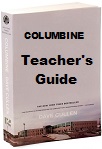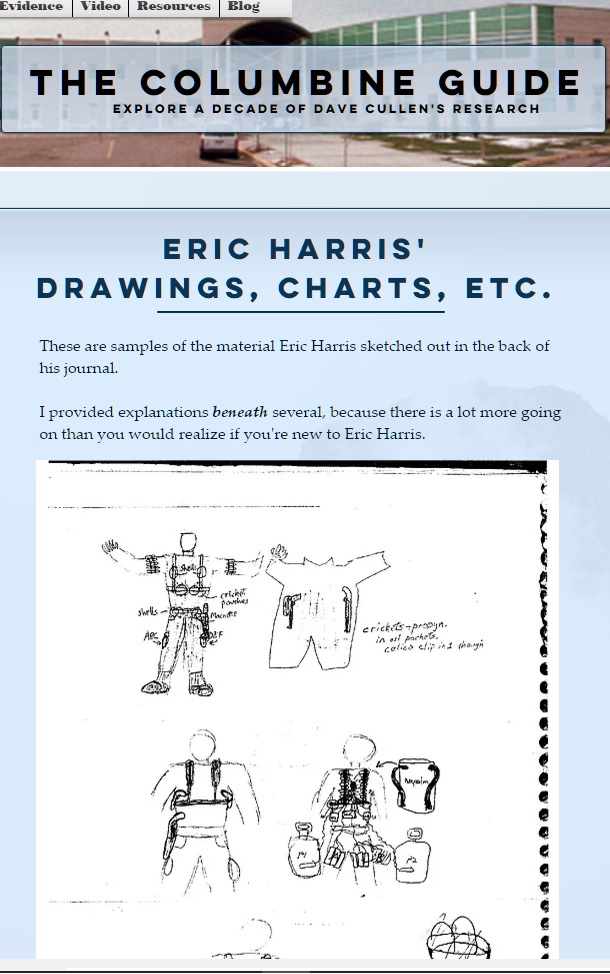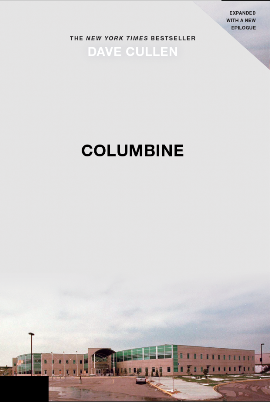Analytical Writing Excercises
Critical Thinking
See also the Creative Writing section. All suggested outside readings are online, linked at the book’s online bibliography.
Problem-Solution / Research
- Do an initial Columbine reading, then investigate one controversial aspect of the event. Write a 5-page problem-solution essay proposing how one of the issues related to Columbine could be resolved. (Reading topics below can be referenced in the index of Columbine).
- Perimeter, police response, SWAT team action & reaction time
- Eric Harris as psychopath and why no one “knew”
- Gun laws and minors
Suggested Columbine reading:
- Chapter 2 “Rebels” pp. 6-12
- Chapter 4 “Rock ‘n’ Bowl” pp. 16-18
- Chapter 5 “Two Columbines” pp. 19-25
- Chapter 6 “His Future” pp. 26-28
- Chapter 8 “Maximum Human Density" pp. 32-36
- Chapter 10 “Judgment” pp. 40-44
Comparison and Contrast or Analysis (The Killers)
- Look up 2-3 of the newspaper pieces on Columbine below, which the author cited as reliable. Write a 2-3 page essay on what we learned about the killers over time. How did our understanding of them change between 1999 and today? What new sources or material became available, and how did it shape our perceptions?
- “The Columbine Killers” – David Brooks, New York Times
- “Fatal Friendship: How Two Suburban Boys Traded Baseball and Bowling for Murder and Madness” – Lynn Bartells and Carla Crowder, Rocky Mountain News
- “The Gunmen: A Portrait of Two Killers at War with Themselves” – Dirk Johnson and Jodi Wilgoren, The New York Times.
- "I Will Never Know Why"– Sue Klebold, O: the Oprah Magazine.
- “The Last Columbine Mystery” – Dave Cullen, The Daily Beast.
Suggested outside reading:
Cause & Effect (Myths & Media)
- Research one of the major Columbine myths (bullying, Goths, jocks, outcasts, gays, third shooter, Trench Coat Mafia, Christian martyr). Write a cause-and-effect essay analyzing how the myth began and what effect it had on the investigation, public perception and aftermath of the shootings.
- Chapter 2 “Rebels” pp. 6-12
- Chapter 4 “Rock ‘n’ Bowl” pp. 16-18
- Chapter 6 “His Future” pp. 26-28
- Chapter 8 “Maximum Human Density" pp. 32-36
- Chapter 10 “Judgment” pp. 40-44
- Columbine myths, pp. 149-52, 155-59
- Eric Harris as a psychopath, pp. 239-48
Suggested Columbine reading:
Compare and Contrast (Myths & Media)
- Watch one of the two Columbine-related films the author recommends: April Showers or Zero Day. (Or Michael Moore’s Bowling for Columbine can be substituted.) Write a paper comparing and contrasting the movie with Cullen's book. What point of view does each work take? What is the focus of each story? How reliable do you find each narrator? What information did each rely on?
- Chapter 2 “Rebels” pp. 6-12
- Chapter 4 “Rock ‘n’ Bowl” pp. 16-18
- Chapter 6 “His Future” pp. 26-28
- Chapter 8 “Maximum Human Density" pp. 32-36
- Chapter 10 “Judgment” pp. 40-44
- Columbine myths, pp. 149-52, 155-59
- Eric Harris as a psychopath, pp. 239-148
- Write a 3-5 page essay comparing and contrasting the myths (bullying, Goths, jocks, outcasts, gays, third shooter, Trench Coat Mafia, Christian martyr) with the reality of Columbine, in order to draw conclusions about culture and society.
- Chapter 2 “Rebels” pp. 6-12
- Chapter 4 “Rock ‘n’ Bowl” pp. 16-18
- Chapter 6 “His Future” pp. 26-28
- Chapter 8 “Maximum Human Density" pp. 32-36
- Chapter 10 “Judgment” pp. 40-44
- Columbine myths, pp. 149-52, 155-59
- Eric Harris as a psychopath, pp. 239-148
Suggested Columbine Reading:
Suggested Columbine Reading:
Analysis (Media)
- Write a 3-5 page essay analyzing the media coverage of the event.
Suggested Columbine Reading:- Chapter 8 “Maximum Human Density" pp. 32-36
- Chapter 10 “Judgment” pp. 40-44
- Columbine myths, pp. 149-52, 155-59
- Television coverage, pp. 52-3,56-7, 64-7, 140-42, 149-53, 155-57
Taking a Position (Law Enforcement)
- Research the Active Shooter Protocol, which was developed and widely adopted because of Columbine. Should law enforcement have practiced something similar April 20? The team at Columbine followed the existing protocol they had trained under. Some SWAT members argued during the attack that the protocol should be disregarded, and they should rush in. Take a position and write a 2-3 page paper arguing for what leaders should have done, based on what they knew and believed at the time. (This paper could also be a compare/contrast).
- Chapter 12 “The perimeter” pp. 52-57
- More on the perimeter, pp. 56-67, 58, 59, 64
- Swat teams, pp. 61-63, 81-2, 83-84, 96-7, 142-45, 352-53
- Imagine yourself in a government official’s job (e.g., Columbine dean or county sheriff’s investigator), at a certain moment in the year prior to the attack. Write a 1-page paper describing how you would respond to the information you received. Explain what you believe and how you would interpret the information—what is going on—and assess how you would prioritize it in relation to your other responsibilities.
- Research current gun laws in your area. Are they making an impact? Should they be changed? What bills have been proposed in the legislature in the last five years? What was the result? Discuss the arguments for and against stricter gun laws. Choose a position and defend it.
Suggested Columbine Reading:
Argument
- Either read David Brooks’ op-ed or watch Bowling for Columbine. Write a rhetorical analysis which discusses argument techniques employed by Brooks or Moore.
- “The Columbine Killers” – David Brooks, New York Times
Suggested outside Reading:
Point of View (Parents)
- The killers’ parents have been among the most controversial people involved in the tragedy. They have kept very quiet, but Sue Klebold is the most heavily-documented of the four. In 2009, she published a powerful essay about life with Dylan before the tragedy, and her life with his legacy. She discusses her responsibility for the attack and reactions she has faced from the world around her. The Brooks and Cullen stories, and the book’s afterword offer several more points of view about her. Some of the victims’ parents responded to her essay on Nightline and Good Morning America
- Write one page assessing how you would feel about Sue Klebold’s actions and her statements.
- Now choose a second point of view and write a page assessing the situation for that person.
- Now try a third.
- Finally, write a page describing how you feel. Address how your opinion changed as you considered each point of view.
- “The Columbine Killers” – David Brooks, New York Times
- "I Will Never Know Why"– Sue Klebold, O: the Oprah Magazine.
- “The Last Columbine Mystery” – Dave Cullen, The Daily Beast.
- Transcripts of Nightline and Good Morning America, immediately after Sue Klebold’s essay was published
- Afterword: “Forgiveness”
Choose a point of view—e.g., parent of a victim, friend of the Klebolds, student injured in the tragedy, teacher at Columbine, SWAT team officer, paramedic on-scene, friend of Dylan’s, Tom Klebold, Sue Klebold, or Dylan’s brother Byron.)
-
Suggested outside Reading:
The Writing Process
- Search online for one of the many interviews Cullen did about his process of writing the book. Choose one particular problem he faced and write a one-page summary and response.
Research Practice
- Locate 3-5 sources from Columbine’s bibliography. Write an annotated bibliography entry for each. Include government documents and television and print news as unusual sources.
- Research Dave Cullen’s online resource: Columbine Online. Provide an annotated bibliography for five different source materials posted there.
The Research Paper
- Teen Depression is the most important topic in the book. See the Teen Depression unit for suggested readings and a wealth of different ways to approach the topic. (See any of the special units for paper ideas and readings.)
- Step back from Columbine and consider the broader environment. Investigate high school and college shootings. What are the problems? Is there a profile? What are possible solutions? Have they failed? Why? Which would have affected the outcome at Columbine? Is it representative?
- Chapters 1-10
- Investigate violence in schools from a historical perspective. Has violence changed significantly? Have the tactics or motivations changed? If so, why?
- Chapters 1-10
- Choose from more than fifty topics organized into about a dozen categories on the page devoted to topics for papers and class discussions, under the QUICK TAKES menu.
Suggested Columbine Reading:
Suggested Columbine Reading:




